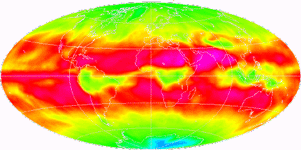Project

NASA Earth Radiation Budget Experiment (ERBE)
Abstract
The Earth Radiation Budget Experiment was designed around three Earth-orbiting satellites: the NASA Earth Radiation Budget Satellite (ERBS), and two NOAA satellites. The data from these satellites were used to study the radiation budget, which represents the balance between incoming energy from the Sun and outgoing thermal (longwave) and reflected (shortwave) energy from the Earth. The Earth's radiation budget is the primary indicator of global climate change. The absorbed shortwave radiation (incident minus reflected) fuels the earth's climate and biosphere systems. The longwave radiation represents the exhaust heat emitted to space. It can be used to estimate the insulating effect of the atmosphere (the greenhouse effect). It was also a useful indicator of cloud amount and activity. Consequently the ERBE has helped scientists worldwide better understand how clouds and aerosols, as well as some chemical compounds in the atmosphere (greenhouse gases), affect the Earth's daily and long-term weather (the Earth's climate). In addition, the ERBE data has helped scientists better understand how the amount of energy emitted by the Earth varies from day to night. These diurnal changes are also very important aspects of our daily weather and climate.
In the 1970's, NASA recognised the importance of the radiation budget and its effects on the Earth's climate. Langley Research Centre was charged with developing a new generation of instrumentation to make accurate regional and global measurements of the components of the radiation budget. The Goddard Space Flight Centre built the Earth Radiation Budget Satellite (ERBS) on which the first ERBE instruments were launched by the Space Shuttle Challenger in 1984. ERBE instruments were also launched on two National Oceanic and Atmospheric Administration (NOAA) weather monitoring satellites; NOAA 9 and NOAA 10, in 1984 and 1986.
The ERBE instrument aboard ERBS, launched from the Space Shuttle Challenger in October 1984 (STS-41G), had the main aim of providing accurate measurements of incoming solar energy and shortwave and longwave radiation reflected or emitted from the Earth back into space. The other goals of the Earth Radiation Budget Experiment (ERBE) are:
-to understand the radiation balance between the Sun, Earth, atmosphere and space which drives our weather and climate system.
-to establish an accurate, long-term baseline dataset for studying climate system changes.
All of the initial goals were meet, and the ERBE instrument continues to provide valuable data. Earth Radiation Budget Experiment (ERBE) data are fundamental to the development of realistic climate models and for studying natural and anthropogenic perturbations of the climate system.
This CD-ROM contains data and colour images from scanning radiometers on the three ERBE satellites and for combined satellite cases. The CD-ROM is written using the ISO-9660 standard. Monthly average values are included for the time periods during which the scanners were operational.
Details
| Keywords: | ERBE, albedo, radiation, cloud forcing |
|---|---|
| Previously used record identifiers: |
http://badc.nerc.ac.uk/view/badc.nerc.ac.uk__ATOM__activity_activity_ERBE
|
